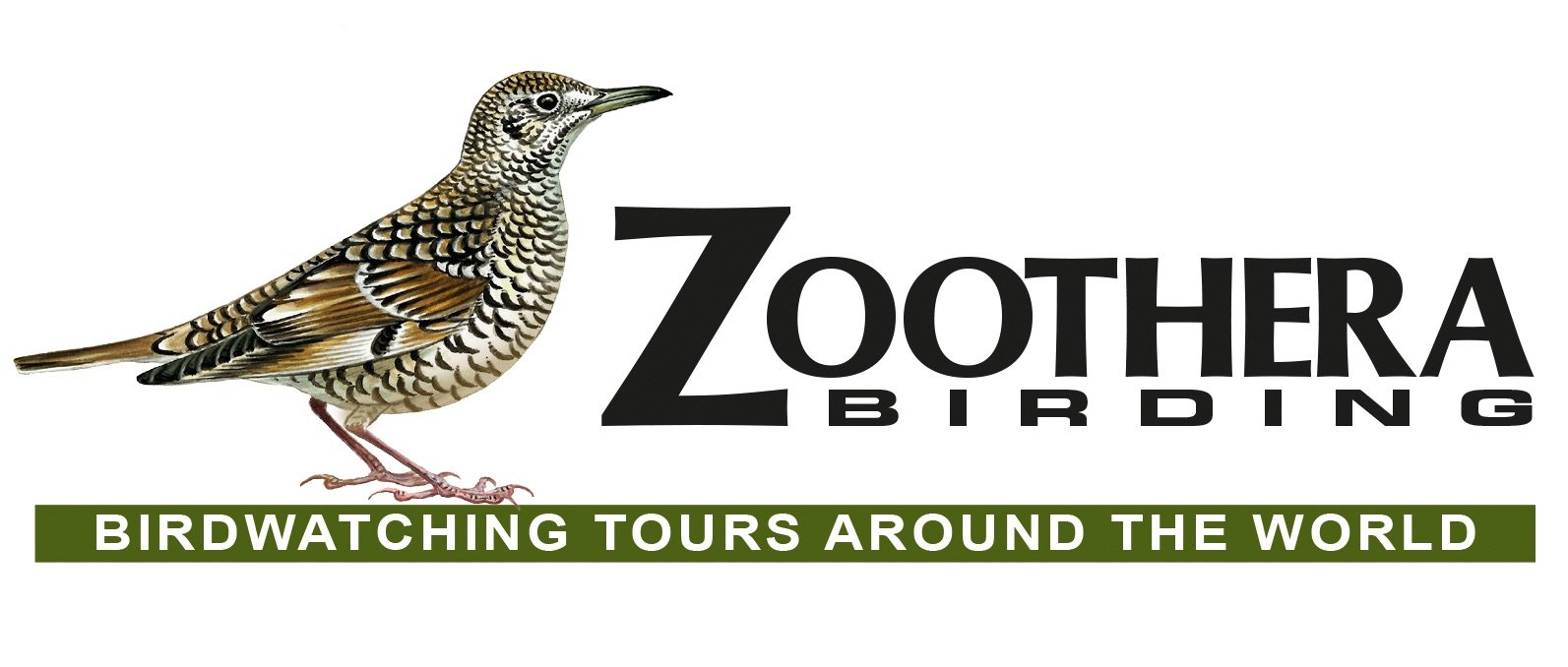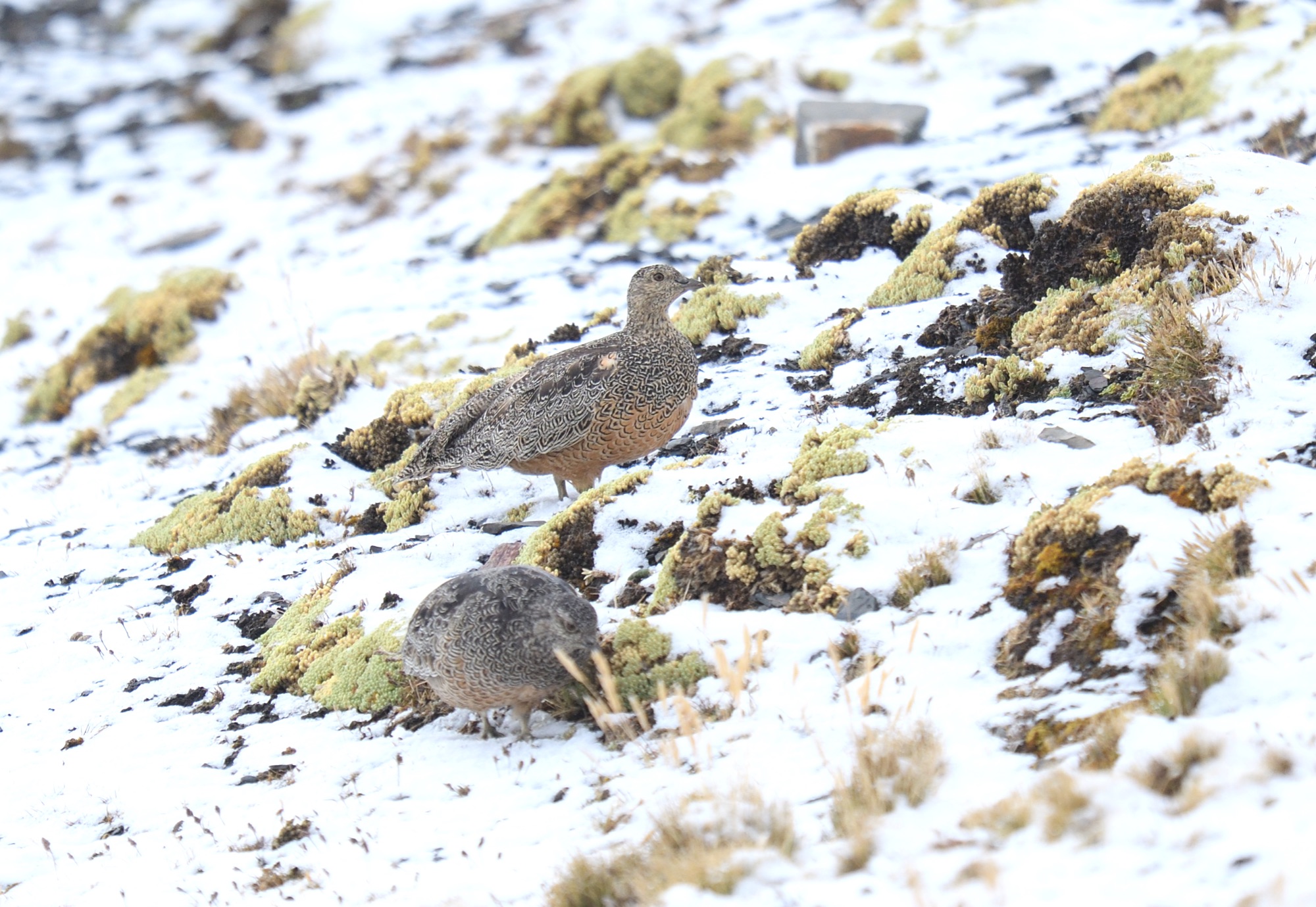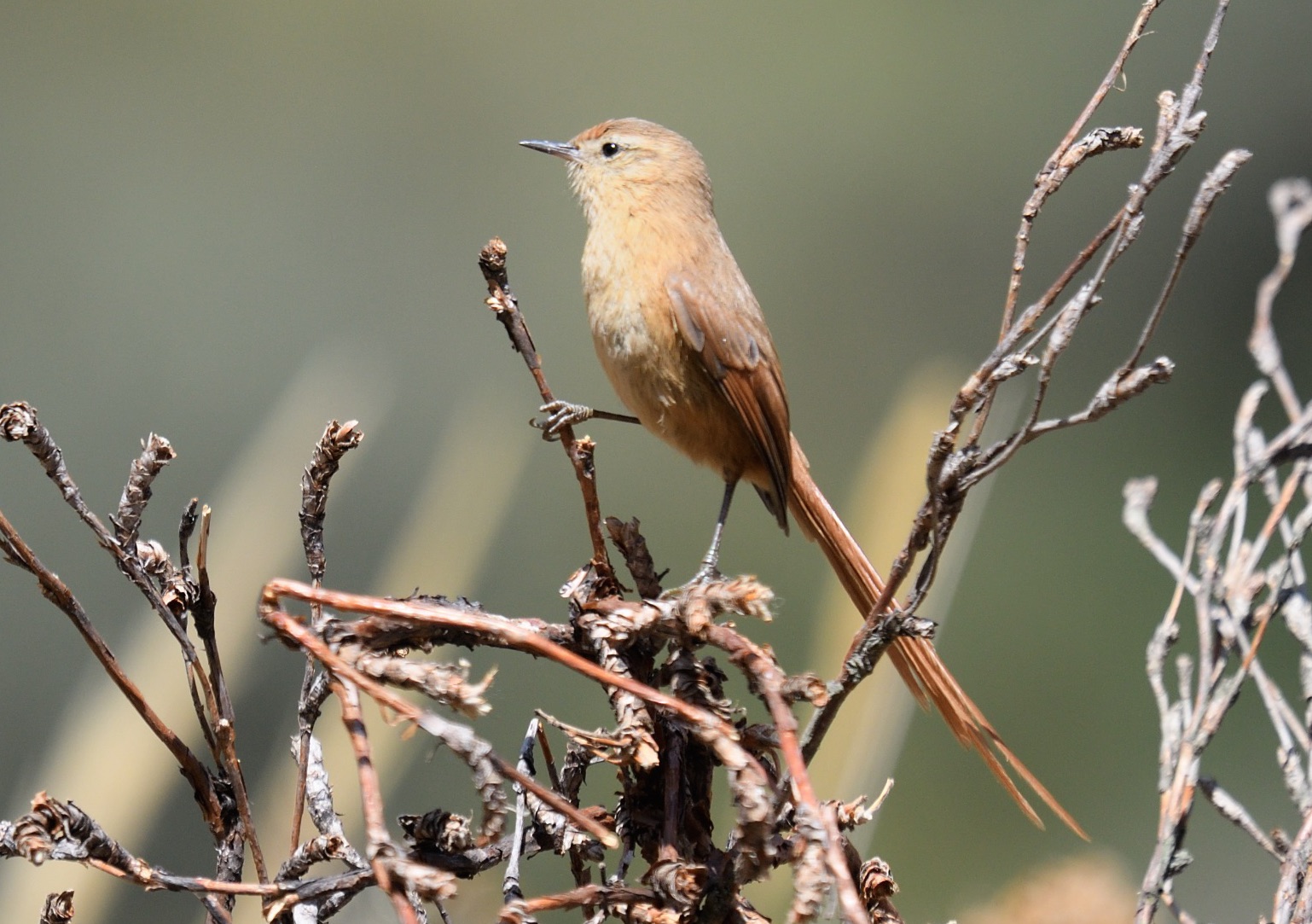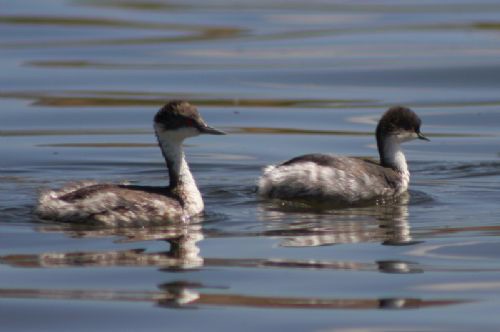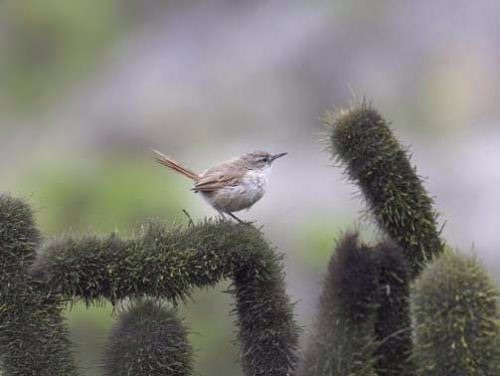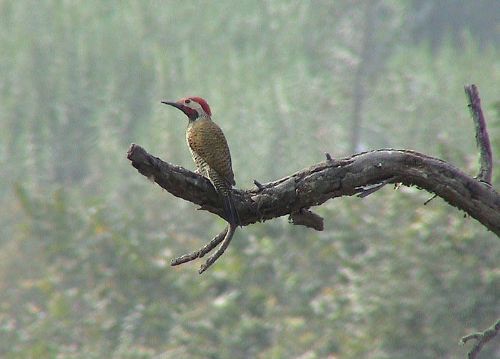CENTRAL PERU ENDEMICS TOUR
Day 1 Arrive - Lima - 8th August
Today is purely an arrival day into Jorge Chavez International Airport, Lima and no activities are planned. We will transfer to a nearby hotel for the night in preparation for an early start tomorrow. Overnight Lima.
Day 2 Lomas de Lachay - Paraiso
We will leave early in order to be at the south side of Lomas de Lachay at the perfect time to look for Cactus Canastero (E), while our driver is preparing breakfast! Amongst the fog enshrouded hills we also look for Greyish (NE) and Thick-billed Miners (E) and the increasingly difficult Raimondi’s Yellow-Finch (E). Later we’ll enter the main track to the reserve and look for Least Seedsnipe, Peruvian Thick-knee, the rare Tawny-throated Dotterel, Oasis (NE) and Amazilia Hummingbirds, Purple-collared Woodstar, Mountain Parakeet, Aplomado Falcon, Coastal Miner (E), Peruvian Pipit (a potential split from Yellowish Pipit), Peruvian Meadowlark, Grassland Yellow Finch, Band-tailed Sierra Finch and many more. Once we are finished here we will head north along the coast to Paraiso Lagoon where we can see a variety of more widespread species such as Chilean Flamingo, Great & White-tufted Grebes, a number of other waterbirds, the first returning North American shorebirds and sometimes Peruvian & South American Terns. We can also check the beach and shore for Peruvian Pelican, Peruvian Booby, Guanay and the rarer Red-legged Cormorant, Blackish Oystercatcher, Grey, Grey-hooded & Band-tailed Gulls, and hopefully there will be a flyby Inca Tern. Somewhere today we could also see Pacific Parrotlet, Cordilleran Parakeet, Tooth-billed Tanager and possibly a surprise or three! We’ll spend the night in Pativilca.
Day 3 Patavilca Valley - Conococha Lake
We will explore the seldom-birded Patavilca valley this morning at mid-altitudes, which has turned up some surprising records over the past few years including more northerly species such as Peruvian Plantcutter (E), Rufous Flycatcher (E), Piura Chat-Tyrant (E), Baird’s Flycatcher (NE) and Bay-crowned Brush-Finch amongst others. More widespread species include Pacific Parrotlet, Scarlet-fronted & Yellow-chevroned Parakeets, Peruvian Pygmy Owl, Long-tailed Mockingbird, Chestnut-throated Seedeater and much more. We shall spend most of the first part of the day at moderate altitude looking for specialties such as Russet-bellied Spinetail (E), Streak-backed & Cordilleran Canasteros, Great Inca-Finch (E) and there's another chance of the localised Bay-crowned Brush-Finch along the way.
By late morning we will ascend to Conococha lake (4000m) for a short stop where species such as Silvery & White-tufted Grebes, Giant Coot, Andean Goose, Andean Duck and other wildfowl reside, Cream-winged & White-winged Cinclodes and Andean Negrito can be seen. Patches of forest as we descend hold Piura Chat-Tyrant (E) and Rufous-breasted Warbling-Finch (E) before we continue down into the Huaylas valley with a stop for Green-headed Hillstar (NE) along the way. We will eventually reach our hotel in Caraz ( 2250m) during the early evening where we will spend the night.
Day 4 Quebrada Llanganuco
We start the morning beyond the pass with stunning views of the Cordillera Blanca and a nice field breakfast as the sun hits the Polylepis forest - this is the best time of day for the much-wanted endemic White-cheeked Cotinga (E). Afterwards we will backtrack to Laguna Llanganuco looking for Stripe-headed Antpitta (NE), Tit-like Dacnis and Ancash Tapaculo (E) on the way, whilst the open areas have D’Orbigny’s Chat-Tyrant, Tawny Tit-Spinetail, Rufous-webbed Tyrant, Rufous-naped, Plain-capped & Puna Ground-Tyrants amongst others. We will then continue down the Doña Josefa Trail for species such as Black Metaltail (E), Blue-mantled Thornbill, Rusty-crowned Tit-Spinetail (E), Line-cheeked Spinetail (NE), Rufous-eared Brush-Finch (E) and Plain-tailed Warbling-Finch (E), whilst we could also pick up Giant Conebill and Jelski's Chat-Tyrant (NE) amongst others. Night in Caraz.
Day 5 Pueblo Libre - Huascaran National Park - Huanuco
Early this morning we will make a special effort to find an as yet undescribed form of the endemic Pale-tailed Canastero (E), which probably is a good species (better named Creamy-breasted Canastero), and when it is formally described, it will likely be classified as Critically Endangered as there are few known places where it occurs and its preferred cactus habitat has been converted to goat grazing areas. The same area also holds the endemic Spot-throated Hummingbird (E) as well, but we won't linger too long as there's a long journey ahead. The rest of the day will see us driving to Huanuco via La Union where we cross the Marañon making just a couple of stops along the way to search for any species we still need so far such as Grey-breasted & Rufous-bellied Seedsnipes amongst others and should arrive at our next hotel in time for a late supper. Night in Huanuco.
Days 6 - 7 Bosque Unchog
We have 2 full days to explore this incredible area, where the focus will be on an astonishingly high number of endemics residing amidst the beautiful moss-encrusted cloud forest and paramo. A narrow, winding road takes us ever higher towards the treeline and at the highest point we can reach in our vehicles we will begin birding our way up. Probably on our first morning we will arrive at Bosque Unchog before sunrise listening to the display calls of Jameson's Snipe and Swallow-tailed Nightjar, and there's also a slim chance of White-throated Screech-Owl or Lesser Horned Owl here too. It's going to take a good deal of effort to bird this high-altitude site but the rewards are definitely worth it! The main prize amongst a long list of exceptionally amazing species is the legendary endemic Golden-backed Mountain-Tanager (E), classified as Endangered by BirdLife International. It is only found above 3000m in Central Peru in stands of low trees surrounded by paramo and this is pretty much the only relatively easily accessible site to see this magnificent species. The same area will also be searched for the tricky Bay-vented Cotinga (E), as well as Coppery Metaltail (E), and we need a good deal of patience to find the strange-looking Pardusco (E) and Rufous-browed Hemispingus (E) both of which associate with feeding flocks often led by Citrine Warbler. We will spend a great deal of time waiting and scanning for these imporant endemics and patience will be required, as they can roam over a huge area. But we will persevere and during our thorough search will also keep an eye (and an ear!) out for Curve-billed Tinamou, Large-footed Tapaculo (E), Crowned Chat-Tyrant, Red-rumped Bush-Tyrant, Line-fronted Canastero, the plengei race of White-chinned Thistletail ( a proposed split as Peruvian Thistletail), Many-striped Canastero, Yellow-scarfed Tanager (E) and Buff-breasted Mountain-Tanager. Lower down there are flocks with White-banded and White-throated Tyrannulets, Ochraceous-breasted Flycatcher, Rufous-breasted Chat-Tyrant, Barred Fruiteater, Blue-backed Conebill, Grey-browed & Slaty Brushfinches and Golden-collared Tanager. We should also see Sword-billed Hummingbird in this area. As we walk back to our waiting vehicles we shall look for Red-rumped Bush-Tyrant, Paramo Pipit and Neblina Tapaculo (E).
We will bird different areas on our second full day including the now famous Paty Trail, which lays claim to being one of the best birding sites in Peru. This will take us deeper into the cloudforest and give us chances of some of yesterdays species as well as some really difficult skulkers and shyer species such as Yungas Pygmy-Owl, Bay Antpitta (E), Chestnut Antpitta (E), Trilling Tapaculo, Rufous-vented Tapaculo (E), Masked Fruiteater (E), the distinctive race of Green-and-Black Fruiteater that is yet another potential split as Huanuco Fruiteater, Peruvian Tyrannulet (E), Unstreaked Tit-Tyrant (E), Inca Flycatcher (E), Smoky Bush-Tyrant, Peruvian Wren (E) and the always difficult Masked Saltator. Commoner species we should see include White-eared Solitaire, White-collared Jay, Mountain & Fasciated Wrens, Rufous-chested & Flame-faced Tanagers, White-browed & Black-eared Hemispingus and Tricoloured Brushfinch to name just a few. Whilst slightly lower elevation areas hold Golden-browed Chat-Tyrant, Ochraceous-breasted Flycatcher (again), the endemic baroni race of Line-cheeked Spinetail, Black-crested Tit-Tyrant (NE), Plush-capped Finch, Brown-flanked Tanager (E), more tanagers and White-browed Hemispingus (E) amongst others. Nights in Huanuco.
Day 8 Carpish Tunnel - Lake Junin
We have a few options this morning depending on what species we still need to see, so we may do some birding at the Carpish tunnel (2100m-2700m) or visit a section of the Satipo Road for a few hours before driving towards Junin. No doubt there will be one or two true skulkers we can spend the first couple of hours of daylight tracking down such as Large-footed Tapaculo (E), or Tschudi's Tapaculo (E), whilst we probably should have seen Fulvous Antpitta by now - a recent split from Rufous Antpitta. Along the way we can search for Oriole Blackbird, Rufous-backed Inca-Finch (E) and Brown-flanked Tanager (E), bird the good Polylepis forest near La Quinua which has Giant Conebill and Striated Earthcreeper (E) and on the higher areas of our route there's a chance of Ornate Tinamou, Common Miner, Black Siskin and others. Upon arrival at Junin we will explore the marshy edges of the lake for the tricky Junin Rail in the early evening. The taxonomy of this species is under doubt and it may well just be a race (tuerosi) of Black Rail, but either way it will be a lifer for everyone! Night in Junin.
Day 9 Lake Junin
We’ll do a boat trip on the huge Junin Lake for the Critically Endangered Junin Grebe (E) early this morning. Unfortunately this species has undergone a tragic decline in numbers due to water pollution and low water levels and it is estimated there's less than 200 individuals left now, but we should still find at least a few birds. Other species on and around the lake include White-tufted & Silvery Grebes, Puna Teal, Yellow-billed Pintail, Andean Duck, Puna Ibis, Andean Gull, Cinereous Harrier, and often Chilean Flamingo. We shall also keep an eye open for Plumbeous Rail, Andean Avocet, Wren-like Rushbird and Many-coloured Rush-Tyrant. The waterlogged fields and bogs in the area hold Ornate Tinamou, Andean Flicker, Short-billed & Correndera Pipits, Common & Dark-winged Miner (E), Andean Negrito, Black-billed Shrike-Tyrant and Bright-rumped Yellow-Finch, and on the bushy slopes we can also find the endemic Black-breasted Hillstar (E). Once finished here, we will head to La Merced and should arrive in time for some birding in the late afternoon in the hills above the town and wait for Cloud-Forest Screech-Owl to start calling. Night in La Merced.
Day 10 Hacienda Armorique
We will spend the day birding at a much lower elevation around Hacienda Armorique where the habitat is distinctly subtropical and amongst a long list of potential species there's a number of stunning specialites to search for such as Cloud-forest Screech-Owl (E), Ocellated Piculet, Masked Fruiteater (E), Creamy-bellied Antwren (E) and Cerulean-capped Manakin (E). It's sure to be a really exciting day and there's a long list of potential species to see including Tataupa Tinamou, Black-banded & Rufous-banded Owls, Black-throated Mango, Blue-tailed Emerald, Chestnut-eared Aracari, Lineated & Crimson-crested Woodpeckers, Red-throated Caracara, Red-billed and Blue-headed Parrots, White-eyed Parakeet, Chestnut-backed Antshrike, White-backed Fire-eye, Yellow-browed Tody-Flycatcher, Olive-faced Flatbill, Long-tailed Tyrant, Coraya Wren, Yellow-cheeked & White-winged Becards, Purple-throated Euphonia, Blue-naped Chlorophonia, Crested Oropendola, Paradise, Magpie, Silver-beaked, Blue-necked & Silver-backed Tanagers. The list is constantly growing and no doubt we will be able to find one or two surprises here!
Day 11 Alto Pichita -Bosque Shollett - Laguna Oconal - Satipo
Today we will do a cirucuit around the cloud forest reserve of Bosque Shollet and Laguna Oconal in Villa Rica, or even visit Alto Pichita. The idea is to target yet more difficult species such as Maroon-chested Ground-Dove, Military Macaw, Black-winged Parrot (NE), Masked Fruiteater (E), soon to be described Pasco Antpitta and Peruvian Treehunter. In fact there's a pretty good list of localised, range restricted and tricky species that are hard to find anywhere else and simply cannot be guaranteed such as Cloud-forest Screech-Owl (E), Bay Antpitta (E), Undulated Antpitta, Blackish Antbird, Jet Manakin, Jelski's Black Tyrant, Trilling Tapaculo, Bluish Flowerpiercer and more. Other species here and at another local site include Sickle-winged Guan, Black-and-white Hawk-Eagle, Golden-headed Quetzal, Chestnut-crested Cotinga, Lemon-browed Flycatcher, Cuzco Warbler (E), Oleaginous Hemispingus, Blue-winged Mountain-Tanager, and Yellow-throated, Yellow-crested and Blue-and-Black Tanagers.
On Laguna Oconal there's a chance of Least Grebe, Limpkin, Snail Kite, and a whole bunch of wildfowl, shorebirds and other padders, whilst surrounding areas have Yellow-tufted Woodpecker, Bluish-fronted Jacamar, the crippling Lanceolated Monklet, Inambari Woodcreeper, Olive-faced Flatbill, Olivaceous Greenlet, and quite a few others are possible. Then we shall continue our journey in the late afternoon trying to get Sand-colored Nighthawk at dusk on at the lowest point of the river before arriving in Satipo. Night in Satipo.
DAY 12 Satipo Road
The forested slopes of the Satipo Road has a gradient ranging from 1000 meters to 3600m, as well as access to a lake on top. The list of birds is phenomenal and includes some iconic and mouth-watering South American species such as Torrent Duck, Sunbittern, Black-and-Chestnut Eagle, Lyre-tailed Nightjar, Chestnut-breasted Coronet, Powerful Woodpecker, Grey-breasted Mountain-Toucan, Andean Cock-of-the-Rock, Barred Fruiteater, Amazonian Umbrellabird, White-capped Dipper, Golden-headed Quetzal, Undulated & Rufous-breasted Antpittas (NE), Pearled Treerunner, Red-ruffed Fruitcrow, Rufous-headed Pygmy Tyrant, White-eared Solitaire, Maroon-chested Chat-Tyrant, Chestnut-breasted Wren, Plush-capped Finch, White-browed Hemispingus (E), Lacrimose Mountain Tanager, Oleaginous Hemispingus, Grass-green and Saffron-crowned Tanagers.
But there's so much more and a seemingly endless list of possibilities include species such as Andean Guan, Solitary Eagle, White-rumped Hawk, Swallow-tailed Nightjar, Fawn-breasted Brilliant, Bronzy & Collared Incas, Amethyst-throated Sunangel, Emerald-bellied Puffleg, Masked Trogon, Black-throated & Blue-banded Toucanets, Scaly-naped & Speckle-faced Parrots, Bar-bellied & Crimson-mantled Woodpeckers, Band-tailed Fruiteater, Rufous Motmot, Crested Quetzal, Rufous Spinetail, Streaked Tuftedcheek, Striped Treehunter, Strong-billed & Montane Woodcreepers, Rusty-winged Barbtail, Buff-browed Foliage-Gleaner, Uniform Antshrike, Flavescent, Cinnamon, Slaty-capped & Golden-crowned Flycatchers, Sulphur-bellied & White-tailed Tyrannulets, Smoke-colored Pewee, Smoky Bush-Tyrant, Barred Becard, Grey-breasted Wood-Wren, Mountain Wren, Glossy-black Thrush, White-collared Jay, Brown-capped Vireo, Russet-crowned & Citrine Warblers, Yellow-whiskered & Grey-hooded Bush-Tanagers, Tricolored, Slaty & White-browed Brush-Finches, Drab, Superciliaried & Black-eared Hemispingus, Rufous-crested, Blue-capped & Beryl-spangled Tanagers, Hooded Mountain-Tanager and Yellow-billed Cacique amongst many others.
This promises to be the 'birdiest' day of the tour as we will surely come across numerous mixed-species feeding flocks that at once dazzle and equally frustrate us as some of the flocks are fabuloulsy huge. By walking slowly downhill we will spend most of the day working the roadside forest from the cloud forest down to the Upper Subtropical Zone and which guarantees a fantastic wide range of species. Night in Colibri Cloud Forest Lodge at Apaya village.
DAY 13 Andamarca Valley
We will make an excursion into the drier Andamarca valley in the Mantaro area with several stops on the way. A number of endemic birds have been seen along this stretch, including some taxa that are not officially named, and species we will look for include Koepcke’s Screech-Owl (E), Fiery-throated Metaltail (E), Stripe-headed Antpitta (NE), “Mantaro” Thornbird (undescribed), Eye-ringed Thistletail (E), Striated Earthcreeper (E), Creamy-crested Spinetail (E), Marcapata Spinetail weskei race (E), an unsdescribed form of Azara’s Spinetail, “Milpo” Tapaculo (undescribed), Junin Tapaculo (E), “Mantaro” Wren (undescribed), and possibly the biggest prize of the lot, Black-spectacled Brush Finch (E).
Other species here include White-throated Hawk, Violet-throated Starfrontlet, Purple-backed Thornbill, Red-crested Cotinga, Peruvian Treehunter, Sierran Elaenia, Brown-backed Chat-Tyrant, Tufted Tit-Tyrant, White-winged Black-Tyrant, Pale-legged Warbler, Moustached Flowerpeircer, Golden-billed Saltator and others. Night in Colibri Cloud Forest Lodge.
Day 14 Satipo Road
We will spend another full day along the Satipo road picking up any species we may have missed on our first full day and we'll be looking for some really big mixed species flocks throughout the day. There's a high degree of flexibility planned around today and we may well drive to different elevations in search of specific species that we still need. Night in La Merced.
Days 15 - 16 Satipo Road - Ticlio Bog - Marcapomacocha - Upper Santa Eulalia
After spending the first couple hours of daylight amidst the bird-rich cloud forest of the famous Satipo Road, we will drive to Ticlio Bog, where our primary target will be the endemic White-bellied Cinclodes (E). Over these 2 days we will also visit the more famous site at Marcapomacocha and between these couple of high-altitude bogs we should see one of the best waders in the world - Diademed Sandpiper-Plover. But there's so many more target species here such as Puna Tinamou, Puna Snipe, Black-breasted Hillstar (E), Olivaceous Thornbill, White-bellied Cinclodes (E), Dark-winged Miner (E), Slender-billed Miner and White-winged Diuca-Finch. A fine supporting cast present in these stunning high-altitude sites include Andean Goose, Crested Duck, Mountain Caracara, Grey-breasted Seedsnipe, Andean Lapwing, Buff-breasted Earthcreeper, Bar-winged Cinclodes, Streak-throated Canastero, White-fronted, Puna, Cinereous, Taczanowski's, Rufous-naped & Ochre-naped Ground-Tyrants, Black Siskin, Mourning, Ash-breasted & Plumbeous Sierra-Finches and Bright-rumped Yellow-Finch.
After crossing two passes at around 4900m altitude and looking out for Rufous-bellied Seedsnipe and Puna Tinamou, we will descend to the Milloc area with a stop for Junin Canastero (E) and Rufous-webbed Bush-Tyrant on the way to the Polylepis Woodland. Most likely there is very little we need here as there is a lot of overlap with Cordillera Blanca. However, special birds for this site include Black Metaltail (E), Stripe-headed Antpitta (NE), White-cheeked Cotinga (E), Rusty-crowned Tit-Spinetail (E), Streak-backed Tit-Spinetail (NE), Striated Earthcreeper (E), Thick-billed, Black & Yellow-rumped Siskins, as well as plenty of more widespread Andean species. Moving just a little lower in altitude could give us Bronze-tailed Comet (E), White-winged Cinclodes and Canyon Canastero (NE) before arriving at Huachupampa where we shall look out for Andean Condors coming into roost as well as being alert for any sign of the tricky Rufous-breasted Warbling-Finch (E). Night in village hotel of Huachupampa.
DAY 17 Santa Eulalia Canyon - Lima
We will continue to look for the endemic Rufous-breasted Warbling-Finch (E) this morning, but there's a number of other Santa Eulalia specialties to find such as Bronze-tailed Comet (E), Black-necked Woodpecker (E), Canyon Canastero (NE), Collared Warbling-Finch, Rusty-bellied Brush-Finch (E) and Great Inca-Finch (E). A fine supporting cast includes Bare-faced & Black-winged Ground-Doves, Giant Hummingbird, Peruvian Sheartail, White-collared & Andean Swifts, White-browed Chat-Tyrant, Streak-throated Bush-Tyrant, Spot-billed Ground Tyrant, Pied-crested & Yellow-billed Tit-Tyrants, White-capped Dipper, Long-tailed Mockingbird, Scrub Blackbird, Chiguanco Thrush, Golden-bellied Grosbeak, Blue-and-Yellow Tanager, Mourning & Peruvian Sierra-Finches, Band-tailed Seedeater and Greenish Yellow Finch. After a successful day we will head back to Lima and our final evening together. Night in Lima.
Day 18 End of Tour - 25th August
The tour will conclude after breakfast this morning.
There is also the chance of an optional 3 day extension that includes a pelagic out of Punta Lomas - ask our office for details.
All photos copyright Nick Bray/Zoothera Birding unless otherwise stated.
.
E denotes endemics Peruvian species
NE denotes near endemics species.
